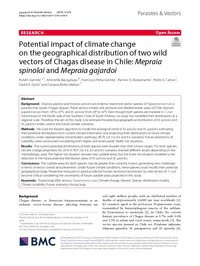Mostrar el registro sencillo de la publicación
Potential impact of climate change on the geographical distribution of two wild vectors of chagas disease in Chile: mepraia spinolai and mepraia gajardoi
| dc.contributor.author | Garrido, Rubén | |
| dc.contributor.author | Bacigalupo, Antonella | |
| dc.contributor.author | Peña-Gómez, Francisco | |
| dc.contributor.author | Bustamante, Ramiro | |
| dc.contributor.author | Cattan, Pedro E. | |
| dc.contributor.author | Gorla, David E. | |
| dc.contributor.author | Botto-Mahan, Carezza | |
| dc.date.accessioned | 2023-03-29T12:23:11Z | |
| dc.date.available | 2023-03-29T12:23:11Z | |
| dc.date.issued | 2019 | |
| dc.identifier.uri | http://repositorio.ucm.cl/handle/ucm/4573 | |
| dc.description.abstract | Background: Mepraia gajardoi and Mepraia spinolai are endemic triatomine vector species of Trypanosoma cruzi, a parasite that causes Chagas disease. These vectors inhabit arid, semiarid and Mediterranean areas of Chile. Mepraia gajardoi occurs from 18° to 25°S, and M. spinolai from 26° to 34°S. Even though both species are involved in T. cruzi transmission in the Pacific side of the Southern Cone of South America, no study has modelled their distributions at a regional scale. Therefore, the aim of this study is to estimate the potential geographical distribution of M. spinolai and M. gajardoi under current and future climate scenarios. Methods: We used the Maxent algorithm to model the ecological niche of M. spinolai and M. gajardoi, estimating their potential distributions from current climate information and projecting their distributions to future climatic conditions under representative concentration pathways (RCP) 2.6, 4.5, 6.0 and 8.5 scenarios. Future predictions of suitability were constructed considering both higher and lower public health risk situations. Results: The current potential distributions of both species were broader than their known ranges. For both species, climate change projections for 2070 in RCP 2.6, 4.5, 6.0 and 8.5 scenarios showed different results depending on the methodology used. The higher risk situation showed new suitable areas, but the lower risk situation modelled a net reduction in the future potential distribution areas of M. spinolai and M. gajardoi. Conclusions: The suitable areas for both species may be greater than currently known, generating new challenges in terms of vector control and prevention. Under future climate conditions, these species could modify their potential geographical range. Preventive measures to avoid accidental human vectorial transmission by wild vectors of T. cruzi become critical considering the uncertainty of future suitable areas projected in this study. | es_CL |
| dc.language.iso | en | es_CL |
| dc.rights | Atribución-NoComercial-SinDerivadas 3.0 Chile | * |
| dc.rights.uri | http://creativecommons.org/licenses/by-nc-nd/3.0/cl/ | * |
| dc.source | Parasites Vectors, 12(1), 478 | es_CL |
| dc.subject | Triatominae | es_CL |
| dc.subject | Wild vectors | es_CL |
| dc.subject | Trypanosoma cruzi | es_CL |
| dc.subject | Climate change | es_CL |
| dc.subject | Maxent | es_CL |
| dc.subject | Species distribution models | es_CL |
| dc.subject | Climate suitability | es_CL |
| dc.subject | Future scenarios | es_CL |
| dc.subject | Kissing bugs | es_CL |
| dc.title | Potential impact of climate change on the geographical distribution of two wild vectors of chagas disease in Chile: mepraia spinolai and mepraia gajardoi | es_CL |
| dc.type | Article | es_CL |
| dc.ucm.facultad | Facultad de Ciencias Básicas | es_CL |
| dc.ucm.indexacion | Scopus | es_CL |
| dc.ucm.indexacion | Isi | es_CL |
| dc.ucm.doi | doi.org/10.1186/s13071-019-3744-9 | es_CL |



